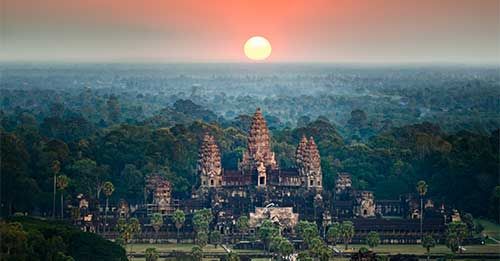
Siem Reap
Located in northwest Cambodia, Siem Reap is a resort town and the portal to the Angkor ruins. The ancient complex was the base of the Khmer kingdom during the 9th through 15 centuries. Angkor's large complex of stone buildings features the main temple of Angor Wat, which also is featured on the Cambodian flag. You can also see mysterious expressions displayed at the Bayon Temple at Angkor Thom. The Old Market in Siem Reap is popular because of its bar, pubs, and restaurants.
Best Time To Visit
Visit the attraction between November and April when skies are clear and sunny.
You Should Know
Night markets in the Old Market area set up in the afternoon and stay open until late at night. Before you visit the temple complex of Angkor Wat, pay a visit to the Angkor Wat Museum. The museum allows you to learn more about Angkorian antiquities, and the ancient history and culture of the area during the Khmer era. 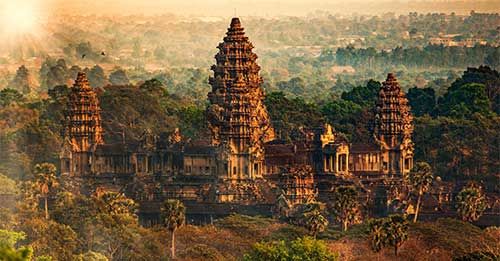
Angor Wat
You simply cannot take one of the Cambodian river cruises featured online without visiting Angor Wat. You will need to head deep into the rainforest to find the lost city and religious monument. The temple facility is distinguished as being the biggest in the world. Large tree roots wrap around many of the temples and bas-relief carvings tell ancient tales.
Best Time To Visit
November through April is the most auspicious time to see Angkor Wat.
You Should Know
The temple has been shared by two religions – Hinduism and Buddhism. At the end of the 12th century, the temple was being used for Buddhist worship. It is still used for practicing Buddhism today. The Angor Wat temple was thought to be designed for funerals because of its westward-facing direction. Usually, Angkorian temples face east while death is symbolized by facing a building west. The building of Angkor Wat required 300,000 laborers and 6,000 elephants working over a 35-year period.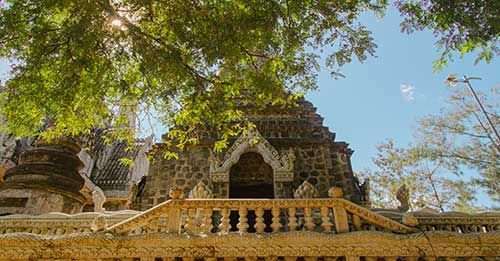
Kampong Cham
Kampong Cham is Cambodia's third-largest city. The rural-like geographical setting of the city contrasts with its thriving city center. While most of Cambodia is primarily Buddhist and Khmer, a large portion of Kampong Cham is Muslim and Christian as well as Chinese. As a result, the city features various religious centers and a variety of foods.
Best Time To Visit
It is best to see Kampong Cham from November through April.
You Should Know
The local market is authentic and does not feature any touristy gimmicks. It is simply a place where the residents buy spices, meat, products, clothes, and toys. Koh Paen Island allows you to experience the farm life in Kampong Chang. You can rent a bicycle and do some exploring. Mountain Srey and Mountain Pros represent two mountains situated west of the city. Mountain Pros is home to pagoda temples, fruit statues, and vendors selling sugar cane juice. If you visit Mountain Srey, you will need to take 308 steps to get to the top. A magnificent abandoned temple will greet you at the top.
Kratié Town
If you want to see Mekong dolphins, you can spot pods when you visit Kratié Town. This part of Cambodia allows you to experience Cambodian village life while seeing some one-of-a-kind sites. The town is home to several pagodas and the largest wat in Cambodia.
Best Time To Visit
Try to visit Kratié Town in November or December when it is drier and more temperate.
You Should Know
Koh Trong Island is a good place to cycle. You will need to catch a ferry, which will deliver you to the island or sandbar in about 5 minutes. It is only about 9 miles around the island, which gives you plenty of time to enjoy the scenery, including the rice paddies, pagodas, and floating village. In the center of town sits Krong Krachen Pagoda, whose gold and pink façade glimmer at sunset.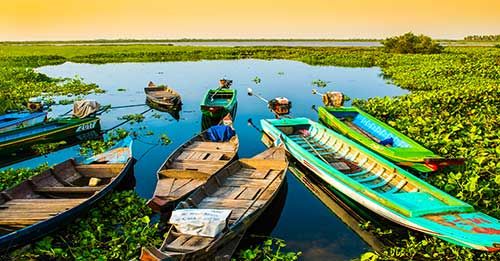
Tonle Sap Lake
During the wet season, Tonle Sap Lake is the largest freshwater lake in Cambodia and Southeast Asia. After the rains, the lake shrinks but is still considered a large body of water. Stretching from Phnom Penh to Angkor Wat, the lake is known for providing for the agricultural needs of the surrounding communities as well as the country's fishing industry.
Best Time To Visit Visit Tonle Sap Lake during the dry season, or November to April, when things are calmer and there are mostly sunny skies. Birds visit the area from December to May, so you may want to schedule a time to see the lake in December.
You Should Know
One of the most attractive floating fishing villages on Tonle Sap Lake is Prek Toal. The village features restaurants, a school, a hospital, and a pagoda. Tonle Sap features fishing lots and floating houses where locals raise and catch fish for a living. 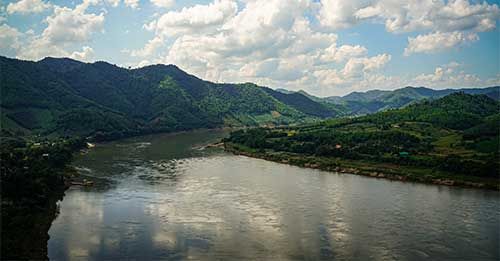
Han Chey Mountain
Known officially as Chey Kiri Mountain, Han Chey Mountain sits on the north side of the Mekong River. You can climb the mountain by taking 295 stair steps. The mountain is home to many temples and a pagoda.
Best Time To Visit
Add Han Chey Mountain to your travel itinerary from November to April.
You Should Know
A temple, called Pra Sat Neang Khmao, lies in the valley of the mountain and is made of stones, each is seven square meters. The pagoda at the mountain's top is called Wat Han Chey. From here, you can enjoy gorgeous views of the Mekong River. A vihara or Buddhist monastery sits at the site.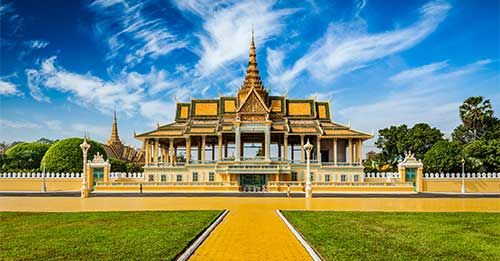
Phnom Penh
The busy capital of Phnom Penh lies at the confluence of the Tonle Sap and Mekong rivers. It was once a base for the Khmer Empire, and later a hub for French colonials. The city's riverfront promenade features bars, restaurants, and parks. Top sites include the National Museum, the Royal Palace, and Silver Pagoda.
Best Time To Visit
Phnom Penh is always pleasant to visit in the spring or fall, especially April or November.
You Should Know
The city's Central Market boasts an Art Deco décor. Besides the Khmer New Year in mid-April, the holiday, P'chum Ben is another significant celebration. During the festival, locals visit pagodas to make offerings to deceased relatives. During the rainy monsoon season in September and October, Phnom Penh can receive a whopping 200 inches of precipitation in one month. 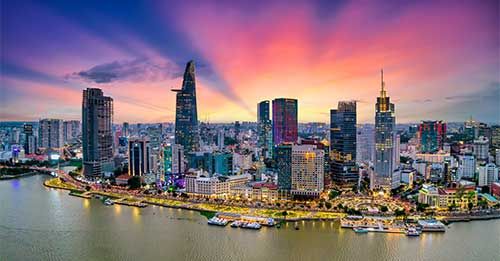
Hoh Chi Minh City, Vietnam
Hoh Chi Minh City is a thriving metropolis and is a great way to conclude or begin a Cambodia river cruise. As the largest city in Vietnam, it offers river cruise-goers with contrasting sites to see – places that may be modern or traditional. When you visit the city, you can enjoy shopping and dining in upmarket venues as well as check out the vendor markets at night.
You Should Know
The city boasts the second-largest number of motorcycle owners in the world, only falling second after Taiwan. Therefore, be very careful about crossing the street. Ho Chi Minh City has some of the best street food in Vietnam. Try vendor specialties, such as cao lau, which is a pork noodle dish, or pho, rice noodles and broth.
Getting There
Getting to the starting point of a
Cambodia river cruise is pretty straightforward. Most cruises kick off from Phnom Penh, the capital city, which is accessible by plane from many international destinations. Once you land, you'll find the city's port nestled along the banks of the Mekong River, often just a short ride from the airport.
If your cruise starts upstream, Siem Reap is your likely launch city near the famous Angkor Wat. Siem Reap is also well-connected by air, and cruise operators often offer transfers from the airport to the port, which is on the Tonle Sap River. Either way, the journey to your cruise ship is an easy one, with these ports serving as gateways to the adventures that await on Cambodia's historic waters.
The Perfect Time for a Cambodia River Cruise
Considering a river cruise in Cambodia requires thoughtful timing due to its tropical climate, which remains warm throughout the year but is characterized by distinct seasons. The dry season, spanning from November to April, is widely regarded as the optimal time for river cruising in Cambodia. During these months, the skies are generally clear, and the countryside is beautifully lush, enhancing the river cruising experience. This period is particularly favorable for river cruising as the water levels in the Mekong and Tonle Sap Rivers are stable, ensuring that all cruise routes are navigable.
On the other hand, the wet season, which lasts from May to October, brings more rainfall to Cambodia. However, this season also transforms the landscapes into even greener vistas, and the rivers swell, occasionally making certain routes accessible that are not available during the dry months. Additionally, river cruising during the wet season in Cambodia might offer better deals and more space for exploration due to fewer tourists.
While most travelers prefer the dry season for its comfort and predictability, the wet season also holds a unique appeal for river cruising in Cambodia. If you're open to experiencing a bit of rain, the wet season can provide a distinctly charming and lush environment for your river cruising adventure. Each season in Cambodia offers a different perspective and experience for river cruising, making it a versatile destination for enthusiasts.
Experience The Flavors of Cambodia on a River Cruise
Cambodian cuisine is all about the balance of flavors. You've got to try 'Fish Amok,' a creamy curry that's like a hug in a bowl. Another star is 'Kuy Teav,' a noodle soup that's perfect for breakfast. Don't skip on 'Bai Sach Chrouk' either; it's pork and rice, simple but oh-so-tasty.
For something to sip, 'Tuk Meric,' a pepper sauce, is a must on pretty much everything. And to wash it down, the local rice wine or a cold 'Angkor Beer' does the trick.
Where to eat? Street food is king here. Find a busy stall, and you're in for a treat. For a sit-down meal, the riverside restaurants in Phnom Penh or Siem Reap offer great local dishes with a view.
On some cruises, you'll get cooking classes or market tours. Join in! It's the best way to understand the local flavors. Just remember to go easy on the spice if you're not used to it.
Immerse Yourself in Cambodia's Culture
Diving into Cambodia's culture is like opening a book that's alive with stories and colors. The Khmer culture, shaped by Theravada Buddhism, is friendly and respectful. When you greet someone, do the 'sampeah,' placing your palms together near your chest and bowing slightly.
Festivals? They're a big deal. Don't miss the 'Water Festival' or 'Bon Om Touk,' where boat races light up the rivers. And 'Pchum Ben,' where Cambodians pay respects to their ancestors, is a time of reflection and community.
Visiting temples? Dress modestly. Cover your shoulders and knees; it's a sign of respect. And remember, shoes off at the door!
Everywhere you go, there's a sense of community, a rhythm of life that's inviting and warm. Smile and show kindness, and you'll fit right in. Cambodia's culture is rich, welcoming, and incredibly beautiful to experience.
Why Book a River Cruise to Cambodia?
Booking a river cruise to Cambodia is a smart move for several reasons. First off, it's a great deal. You get to see and do a lot without the hassle of booking multiple hotels or transportation between cities. Your floating hotel takes you from one incredible spot to another while you sleep or enjoy onboard amenities.
On a river cruise, you also get to see parts of Cambodia that are tough to reach by land. You'll drift past landscapes that aren't just beautiful; they're also unique. Picture yourself sipping your morning coffee as you glide by villages that are waking up, fishermen casting nets, and temples that seem to appear out of nowhere.
The convenience factor is huge, too. Instead of packing and unpacking at each new place, you settle into your cabin, and that's it—you're done. Your room travels with you, and so does your restaurant. Plus, many cruises include guided tours, so you're not just seeing the sights; you're getting the stories behind them.
And then there are the special access perks. Some cruises offer activities and stops that you can't get any other way. Think private tours of ancient temples or evening cultural performances just for guests. That's not something you can easily organize on your own. So, a cruise here isn't just about going places; it's about getting closer to the heart of Cambodia.
Ready to Book Your Cambodia River Cruise?
Are you ready to set off on a journey that's packed with a mix of adventure, tranquility, and cultural richness? A Cambodia River Cruise ticks all these boxes. It's a chance to glide along serene waters, taking in views of lush landscapes and timeless villages. Plus, the ease of travel is unbeatable—you unpack once, and your floating hotel takes you from one extraordinary spot to another.
Imagine waking up to the sight of a misty sunrise over the Mekong, exploring hidden temple ruins, and ending your day with flavorsome local cuisine. On a Cambodia River Cruise, you get an all-in-one experience that combines relaxation with discovery.
Why wait to discover the hidden gems of Cambodia from the unique vantage point of its rivers? Book your cruise today and get ready to create unforgettable memories in this enchanting part of the world.









 1. Free Quote
1. Free Quote 2. Dedicated Travel Consultant
2. Dedicated Travel Consultant 3. Low Price Guaranteed
3. Low Price Guaranteed 4. Stress Free Travel
4. Stress Free Travel

